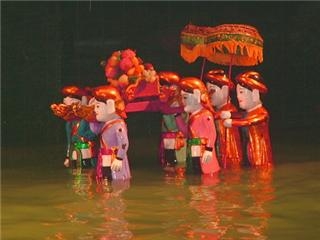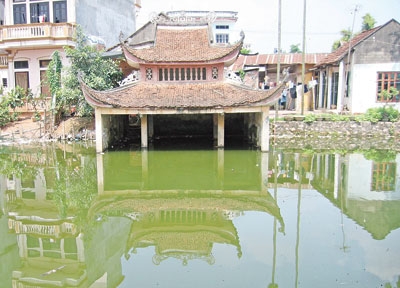A folk artist has devoted his whole life to the art of puppetry, a pride of Vietnam.
 |
| Nguyen Huu Doan introduces his puppets. |
Puppetry has a long and varied history around the globe. The Japanese created the bunraku theatre with black-clad puppeteers, the Indonesians have the Javanese shadow puppets, the European tradition offers the rambunctious Punch and Judy, and American Jim Henson created perhaps the world’s best known puppets in the form of The Muppets. Vietnam’s tradition of animated story-telling stands proudly apart from these other forms of puppetry in one important respect- it takes place in water.
The unique art of water puppetry (Mua Roi Nuoc) in Vietnam has its origins in the Northern Red River Delta, where it first came to prominence around the tenth century. There are now only 14 water puppet troupes working in Vietnam, all of whom take the responsibility of preserving and promoting their ancient art form.
One of the longest serving puppeteers still practicing in Vietnam is folk artist Nguyen Huu Doan, director of the Binh Phu Water Puppetry Troupe in Thach That District, Hanoi. At 68 years of age, Doan has spent more than 40 years of his life traveling with puppets.
“Like most other members of the troupe, I joined very early, at about 20, and from that time, the puppets have been an inseparable part of my life, my destiny,” the puppet master says.
The Binh Phu troupe is one of the oldest in Vietnam, and while Doan says he and his fellow artists are proud to be part of the long-standing puppeteer traditions and are acutely aware of their responsibility to preserve the art, he admits that a life led by the puppets isn’t always simple.
“It is not an easy task,” Doan says, “Although we love the theatre and are willing to devote our time and money to it, life can be hard at times.”
Like most puppeteers in his troupe, Doan was born to a poor farming family who had to struggle hard in the rice fields to make ends meet. It wasn’t a desire to escape a life of back-breaking labour as much as the desire for a different destiny which led Doan to the stage.
“One special feature of our troupe is that all the members are the sons or grandsons of troupe members. When someone in our family retires, another takes over, and so we are something like a family troupe,” he explains.
 |
| A water puppet show. |
Despite the fact that puppeteering is in the blood of most troupe members and they have all been familiar with the water puppets since an early age, Doan says his early years working with the troupe kept him behind the scenes, slowly learning the art of the puppeteers while he helped to set up the shows.
“There is no official class teaching this art, so each new member has to watch and learn from the experienced artists in the troupe,” he says.
It didn’t take long before the young puppeteer found himself in the water controlling the action.
“In every troupe it is the younger artists who work in the water because this work requires good health,” Doan explains. “It was okay in summer but on cold winter days we would have to sip a little salty fish sauce to keep our bodies warm.”
It is only with years of experience behind them that puppeteers like Doan move from the water to dry land to direct the shows.
Like the other puppet troupes in Vietnam, the Binh Phu Troupe has been through many ups and downs, including being forced to stop performing during the war, but Doan says that he and his fellow artists have never given up on the art that has become a part of their very being.
“We know that we have the responsibility to preserve this art for our children,” he says. “After the war, we found many puppets, instruments and other props hidden in pagoda roofs – that shows how treasured the art is.”
In more recent times the art of the water puppets has found its way to the world stage and Doan’s troupe has been invited to perform as far away as Australia, Italy, the USA and Taiwan, receiving great encouragement from audiences everywhere they go and even receiving a grant from the Sweden Fund to preserve and develop their uniquely Vietnamese art.
Doan says that this recognition is the greatest reward of a life dedicated to the world of the water puppets.
Watching a performance by Doan’s troupe, it is easy to see how the traditional art form developed from the simple lives of the farmers.
 |
| The stage for puppet shows in Binh Phu Commune. |
“In the past, the old artists would often stage impromptu shows on the ponds and rice paddies after the harvest,” Doan remembers.
“These public stages were very simple, made of just wood, bamboo and a cloth curtain. We would make the puppets ourselves, carving them from the wood of the fig tree and waterproofing them with resin from the lacquer tree.”
The themes of the performances are rural and have strong references to Vietnamese folklore, with scenes telling the stories of day-to-day life in rural Vietnam and bringing life to traditional folk tales, many of which have a humorous twist.
Stories based around the harvest, fishing and festivals are common, while many of the short skits also relate to local legends and national history. The characters in the performances can be heroic, legendary or mythic, but most are ordinary peasants living in the timeless world of rural Vietnam.
Over the centuries, the puppeteers’ simple stages of wood, bamboo and cloth developed into the permanent structures that draw audiences from around the world to theatres like that run by the Thang Long Puppet Troupe in Hanoi today. Despite these buildings with their tickets, ushers and ranked seating, it is the folk artists like Doan from the 14 troupes around northern Vietnam who are quietly keeping this famous art alive in the village ponds and rice paddies where it was born a thousand years ago.

Leave your comment on this story